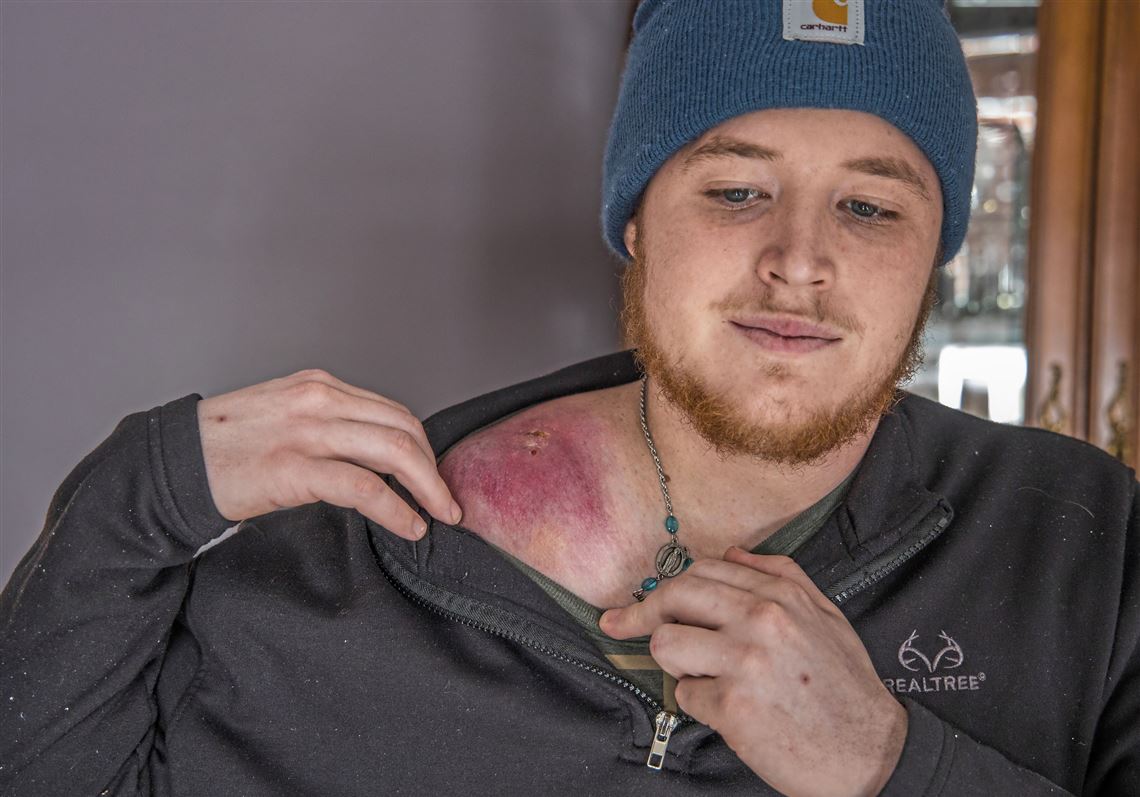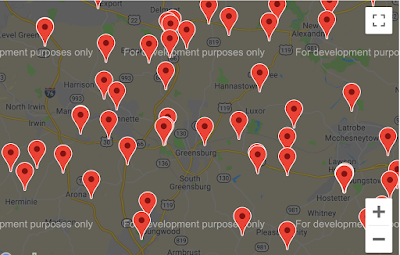Ewing sarcoma is a type of bone cancer. No mention in the following article of the fact that bones absorb radiation heat.
Residents of the area are asking if radiation may be the cause of all the childhood cancers in the area.
A quick google search of cell towers near Canonsburg, PA brings up the following image…
Cell tower density for Greensburg, PA (also mentioned in the article) is even worse.
PA is also forcing smart meters onto people’s homes.
Source Article: CDC, state officials investigating multiple cases of rare cancer in southwestern Pa. https://www.post-gazette.com/news/health/2019/03/28/Ewing-sarcoma-Washington-Westmoreland-cancer-Canon-McMillan-school-cecil-pennsylvania/stories/201903280010

Many in the Canon-McMillan School District first learned about Ewing sarcoma, a rare childhood bone cancer, when Luke Blanock of the village of Cecil was diagnosed on Dec. 5, 2014.
The media did stories about the community rallying around the smart, handsome teenager and his family, then returned on Feb. 19, 2016, to cover Mr. Blanock — pale, thin and having just been told he had only two weeks to live — when he married his high school girlfriend, Natalie Britvich.
He rebounded a bit and even played a round of golf before succumbing nearly six months later on Aug. 7, from multiple tumors of the brain, spine, skull, jaw and pelvis. He was only 19.
But, as it turns out, the Ewing sarcoma scare within Canon-McMillan’s boundaries in eastern Washington County neither began nor ended with Luke Blanock.
In fact, six cases of Ewing sarcoma have been diagnosed within the school district since 2008, including two cases in the past nine months.
And only now is it being disclosed that twice that number of Ewing cases have occurred in southeastern Westmoreland County since 2011.
Only 200 to 250 cases of Ewing sarcoma — a rare cancer of the bone or nearby soft tissue — occur each year in the United States. The National Cancer Institute said the incidence for all ages is one case per million but up to 10 cases per million among those in the 10-to-19 age group.
Based on a report by a concerned resident and St. Vincent College researchers about the Ewing cases in Westmoreland County, the Pennsylvania Department of Health and the U.S. Centers for Disease Control and Prevention launched a study to determine whether these cases constitute a cluster. The state now has expanded the investigation to include the Canon-McMillan School District and Washington County.
Nate Wardle, health department spokesman, said it received more than a dozen phone calls within the last month from residents of Washington and Westmoreland counties about the Ewing sarcoma cases, and several more called this week.
Cases mount up
The string of Ewing cases in Canon-McMillan began with the mid-2008 diagnosis of Curtis Valent, a Cecil Township resident who graduated from Bishop Canevin High School. He died on Jan. 2, 2011, at age 23, according to his obituary. His parents could not be reached for comment.
Late in 2008, Alyssa Chambers, then an 18-year-old Canon-McMillan senior living in northern Cecil Township, was diagnosed with Ewing sarcoma and survived. She later became an oncology nurse at UPMC Shadyside.
Kyle Deliere, who lived about a mile from Mr. Blanock in the village of Cecil, was diagnosed with Ewing next, on Oct. 30, 2011. He lost weight, had night sweats and fevers, and developed large tumors on his hip, femur and lungs. The 11-letter high school athlete who wrestled for the University of Pittsburgh died on Nov. 15, 2013, at age 27.
Then in June 2018, David Cobb, 37 at the time, and also living in Cecil Township, was diagnosed with Ewing sarcoma and now is undergoing rounds of chemotherapy.
Compounding this cancer conundrum and fueling concern, Mitchell Barton, a 21-year-old Canon-McMillan graduate now working as a technician in a local box factory, posted news on Facebook of his Dec. 27, 2018, Ewing diagnosis.
He and Mr. Blanock played baseball together in high school. Mr. Barton, now undergoing chemotherapy, still lives at home in North Strabane, where fracked natural gas wells surround him. For that reason, environmental issues crossed his mind from the moment of diagnosis.
“I worked at a golf course for four years and was exposed to a lot of chemicals, weed killers and things like that,” he said. “Our house also is in a valley surrounded by four gas wells. I heard about natural gas and my mom is concerned about methane [natural gas].”
In addition to the Ewing cases, a 14-year-old girl from Cecil Township died of astrocytoma, a brain and spinal cord cancer, in February, and as many as seven current students and two preschoolers in the Canon-McMillan School District have other types of cancer.
Those nine consist of two cases of osteosarcoma (bone); one liposarcoma (joint); one rhabdomyosarcoma (also joint); a Wilms (kidney) tumor in a child whose family has moved from the district; one liver cancer; two cases of leukemia (blood); and a 2-year-old with cancer that the parent declined to identify.
In another case, a 21-year-old Canon-McMillan graduate of North Strabane was diagnosed in early January with leukemia.
Another concentration of cases
The worries about Ewing and other forms of childhood cancer go well beyond the Canon-McMillan School District.
In Westmoreland County, 12 cases of Ewing sarcoma were found to be diagnosed from 2011 through early 2018.
Maureen Grace, a Westmoreland County lawyer and teacher, began compiling a list upon hearing of one case after another in areas southeast of Greensburg.
“All that I can say is that I saw beautiful children and families suffering. I asked myself, ‘What if this happened to a child in my family?’ Every child, every parent and anyone who cares about children has the right to clean, healthy, safe air, water and surroundings for their babies, little ones and teenagers to grow and become adults. I don’t know if we have this environment right now,” Ms. Grace said.
“Our children are our most precious resource. If we don’t investigate this to the very best of our abilities, who are we as a culture or community?” she added. “We need to do better for our little ones who look to us for the answers. We need to protect them above all else.”
So determined, she sought help from two St. Vincent College researchers — Elaine Bennett, professor of anthropology and public health, and Cynthia Walter, a now-retired professor of ecology and toxicology — who recruited students to help verify cases, analyze results and write a report. Ms. Grace also received help through the Healthy Child/Healthy World Organization.
The research team, known as the Westmoreland County Pa. Ewing Sarcoma Project, submitted its report to the state health department and CDC in December 2017.
Working quietly, Ms. Grace finally responded to longstanding inquiries from the Pittsburgh Post-Gazette and stepped forward with Ms. Walter, who holds a doctorate in biology, to publicize their results.
Ms. Grace said she initially documented eight pediatric Ewing cases and the health department now has expanded that total to 12, when cases involving young adults were included.
Confirming a cluster requires meeting a high statistical and analytical bar, including identifying a pollution or chemical exposure linked to that cancer, according to a Pitt biostatistician.
That presents a problem because Ewing sarcoma has no known cause.
What could be the cause?
The Westmoreland project presented the state with a long list of possible pollution sources, including countywide shale gas drilling and fracking operations and a Penn Township landfill that has accepted thousands of tons of radioactive drill cuttings from gas well sites. The project’s report also makes a case for how pollution exposure could lead to Ewing.
But Ms. Grace said she and the team don’t yet know if fracking, water or air pollution, or pollution from old industry, among other sources of pollution and contamination, are responsible. “We don’t want our aim to stray from seeking a scientific cause and solution,” she said.
The health department said it is reviewing cancer statistics for Washington County and for the Canon-McMillan School District, where it is only aware of four cases but has yet to incorporate 2018 cancer data into its review. In the past decade, two additional Ewing sarcoma cases have occurred in Washington County — one in Charleroi and another in or near Bentleyville — with at least two cases each in Greene and Fayette counties.
The health department also said it has been working with researchers to separately evaluate and monitor Westmoreland County statistics.
Even with 12 Ewing cases, the department does not see a statistically significant excessive number in Westmoreland County, Mr. Wardle said, adding that that finding has been shared with concerned residents of the county. “But we will continue to monitor the number of cases in the area.”
He said the department is doing the statistical evaluation of the Ewing cases in Washington County and now has included all childhood cancers in the study, including those identified by the Post-Gazette.
The Ewing family of sarcoma is not one of the common cancers the department reports on annually, he said. Most cases occur in teens when they experience growth spurts, and science is limited as to what causes it.
The concerned citizens who recently called the health department wanted to know if the cancer cases are related to environmental factors, including radiation, Mr. Wardle said. Washington County has historic radiation issues related to a uranium mill tailings disposal site in North Strabane, near Canonsburg, where the U.S. Department of Energy continues to report background or below background levels of radiation.
Another concern is the widespread drilling and fracking of more than 1,000 shale gas wells, which produce waste water with radioactive components, among other pollutants. The first experimental well in southwestern Pennsylvania was fracked in 2005 in Cecil Township. The township now sits downwind from a phalanx of compressor stations and a hilltop cryogenics plant, a major source of pollution.
Academic studies done in Pennsylvania and Colorado have found higher rates of childhood cancers in areas where fracking is occurring but with no links to Ewing sarcoma.
The Marcellus Shale Coalition, the trade organization representing the shale gas industry in Pennsylvania, issued a statement citing a review of medical data by the American Cancer Society that found “no known lifestyle-related or environmental causes of Ewing tumors ….”
In a statement, David Spigelmyer, coalition president, said attempts to link the incidence of Ewing sarcoma and other childhood cancers to the shale gas drilling industry were without scientific or medical support.



